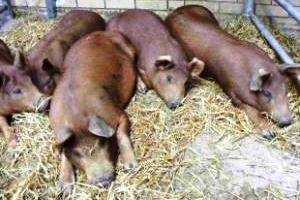RESEARCH: Growth- and fatness-related traits in pigs

Chinese scientists based in Jiangxi province, China, have published an article in Animal Genetics this month examining a genome scan identifying the growth and fatness related traits in a White Duroc and Erhualian F2 intercross pig population.
Growth and fatness are economically important traits in pigs. In this study, a genome scan was performed to detect quantitative trait loci (QTL) for 14 growth and fatness traits related to body weight, backfat thickness and fat weight in a large-scale White Duroc × Erhualian F2 intercross.
A total of 76 genome-wide significant QTL were mapped to 16 chromosomes.
The most significant QTL was found on pig chromosome (SSC) 7 for fatness with unexpectedly small confidence intervals of ∼2 cM, providing an excellent starting point to identify causal variants.
Common QTL for both fatness and growth traits were found on SSC4, 5, 7 and 8, and shared QTL for fat deposition were detected on SSC1, 2 and X.
Time-series analysis of QTL for body weight at six growth stages revealed the continuously significant effects of the QTL on SSC4 at the fattening period and the temporal-specific expression of the QTL on SSC7 at the foetus and fattening stages.
For fatness traits, Chinese Erhualian alleles were associated with increased fat deposition except that at the major QTL on SSC7. For growth traits, most of White Duroc alleles enhanced growth rates except for those at three significant QTL on SSC6, 7 and 9.
The results confirmed many previously reported QTL and also detected novel QTL, revealing the complexity of the genetic basis of growth and fatness in pigs.
Source: Animal Genetics











